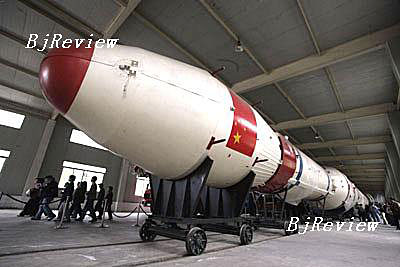
Visitors walk past Long March 3A carrier rocket at the Xichang Satellite Launch Center in Southwest China's Sichuan Province Oct. 18, 2007. (Photo: China Daily)
Even as the scheduled launch of China's first self-development moon orbiter, Chang'e I, draws closer, a nation, and several pockets of the world, watch and wait with bated breath.
The tension and excitement around the Xichang Satellite Launch Center, in southwest China's Sichuan Province, are palpable.
"It will be launched between October 24 and 26, and our first choice is around 6 pm on October 24," said Li Guoping, spokesman for the China National Space Administration, to the press on Monday.
The orbiter will obtain three-dimensional images of the Moon's surface, chart elements on the Moon, measure the thickness of lunar soil, as well as monitor the space environment between the Moon and the Earth.
The Moon orbiter, according to Ouyang Ziyuan, Chief Scientist of Chinese Lunar Exploration Program and an academician at the Chinese Academy of Sciences, is part of the three-step lunar program initiated in January 2004: orbiting the Moon; landing an unmanned vehicle on the Moon, around 2012; bringing back lunar soil and rock samples in the unmanned vehicle by 2017.
"Only after these steps have been taken, can China land human beings on the Moon," Ouyang stated.
The funding for Chang'e I is 1.4 billion yuan or $169 million.
There have been no launch failures in Xichang since 1997, and all the past 14 launches of the Long March 3A were successful. Chang'e I and its booster, the Long March 3A carrier rocket, have passed every pre-launch test, and are ready for lift-off.
Jin Zhiqiang, Deputy General Designer of Long March 3A rockets, believed that it would be a success despite the potential risk.
"We've done plenty of work specifically designed for the launch on the basis of previous successes," he said. "For example, we collect information and analyze lessons from lunar exploration programs led by foreign countries; we analyze problems in quality during development and production; and we take effective measures to correct uncertainties and mistakes on the basis of previous analysis, etc. All in all, it will be a success."
Echoing Jin, Hao Xifan, Deputy Director of the Chinese Lunar Exploration Program Center, admitted that there were some unknown factors in the technical areas.
"We have preparations and alternative solutions," he said. "This is the first time we launch the lunar orbiter, so the most difficult thing we face is lack of first-hand information on the Moon environment. With the successful launch of the Chang'e I, a solid foundation will be laid for the lunar programs to follow."
The lunar orbiter is expected to enter the Earth-Moon transfer orbit on October 31, and the Moon's orbit, 380,000 km away from the Earth, on November 5. It will beam back the first pictures of the Moon in late November and will continue scientific exploration for a year.
According to a report in Elite Reference, newspaper published by China Youth Daily, major news agencies such as AP and AFP covered the imminent launch amidst the 17th National Congress of the Communist Party of China. What's more, Dr. Steve Saunders, the project scientist for the 2001 Mars Odyssey mission of the United States, wished the launch success in an e-mail interview with Elite Reference, saying, "I was impressed by the Chinese Lunar Exploration Program and will be happy to see the upcoming launch of Chang'e I.
If for some reasons, however, the launch does not go through before Friday, the lunar orbiter will have to wait till next April.
"As one of the 16 key programs in the science and technology fields, the Chinese Lunar Exploration Program plays an important role in boosting the nation's technical development," said Hao Xifan. "I believe that the launch of Chang'e I will be successful. At the same time, however, we will have to be brave to face difficulty or even failure. But we will meet the challenge and we will win."
Backgrounder
Chang'e I is the first in a series of Chinese missions to the Moon. The spacecraft, equipped with a CZ-3A booster, is scheduled to be launched on October 24, 2007, and orbit the Moon for a year to test the potential for future missions and study the lunar environment. The orbiter is based on the DFH-3 Comsat bus and will have a mass of roughly 2,350 kg, 130 kg of which will be the scientific payload. The payload will include a stereo camera system to map the lunar surface, an altimeter to measure the distance between the spacecraft and the surface, a gamma/X-ray spectrometer to study the overall composition and radioactive components of the Moon, a microwave radiometer to map the thickness of the lunar regolith, and a system of space environment monitors to collect data on the solar wind and near-lunar region.
The Chang'e I program is named after the legendary Chinese goddess who flew to the Moon. | 